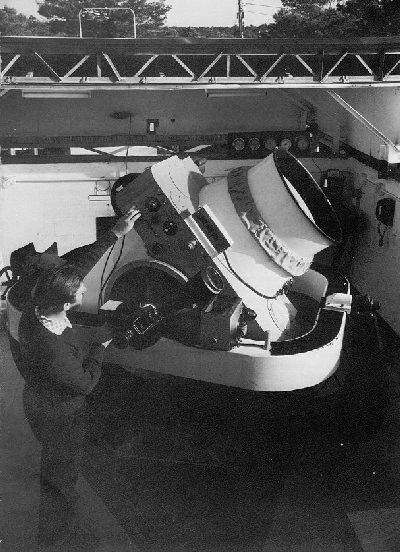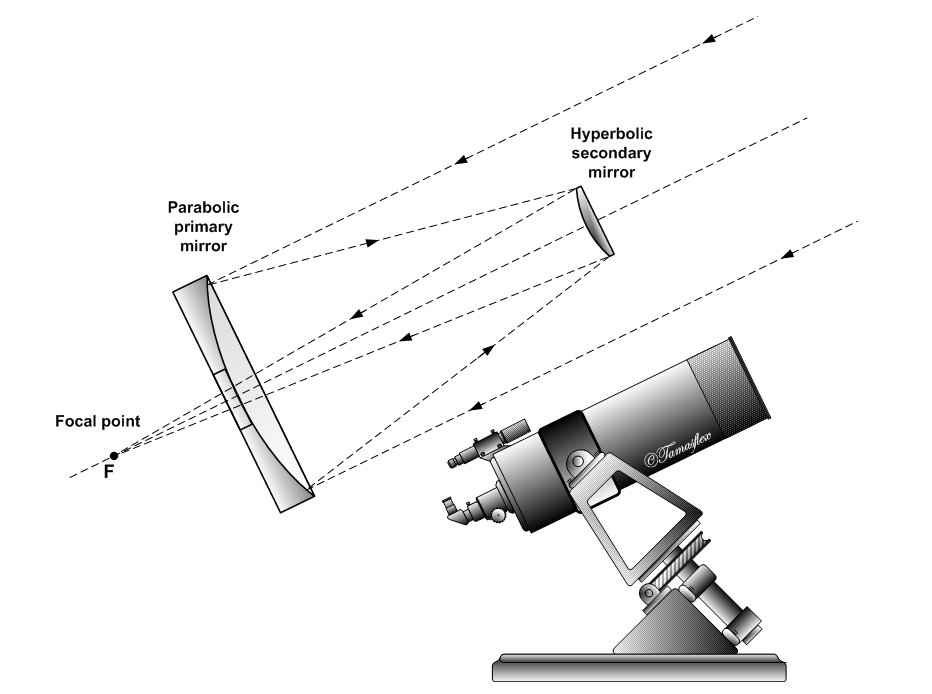|
Sommers–Bausch Observatory
Sommers–Bausch Observatory is an astronomical observatory located on and owned by University of Colorado Boulder. The building was initially completed in 1953 and named after Elmer E. Sommers and Carl L. Bausch. It is operated by the university's Department of Astrophysical and Planetary Sciences (APS), which primarily utilizes the facilities and equipment of the observatory for teaching as well as some research. Telescopes include two 20" Planewave CDK telescopes on Software Bisque Taurus 500 encoder mounts, a 24" Boller and Chivens Cassegrain reflectors, and a 10-inch aperture heliostat (solar telescope). The observatory also possesses multiple smaller telescopes and ancillary equipment. The observatory also houses the lab classroom and the computer lab for the APS department. History In 1949 the University of Colorado received a bequest of $49,054 from the estate of Mayme Sommers in memory of her husband Elmer E. Sommers. These funds were used to construct the observ ... [...More Info...] [...Related Items...] OR: [Wikipedia] [Google] [Baidu] |
University Of Colorado Boulder
The University of Colorado Boulder (CU Boulder, CU, or Colorado) is a public research university in Boulder, Colorado. Founded in 1876, five months before Colorado became a state, it is the flagship university of the University of Colorado system. CU Boulder is a member of the Association of American Universities, a selective group of major research universities in North America, and is classified among R1: Doctoral Universities – Very high research activity. In 2021, the university attracted support of over $634 million for research and spent $536 million on research and development according to the National Science Foundation, ranking it 50th in the nation. The university consists of nine colleges and schools and offers over 150 academic programs, enrolling more than 35,000 students as of January 2022. To date, 5 Nobel Prize laureates, 10 Pulitzer Prize winners, 11 MacArthur "Genius Grant" recipients, 1 Turing Award laureate, and 20 astronauts have been affiliated with ... [...More Info...] [...Related Items...] OR: [Wikipedia] [Google] [Baidu] |
Telescope
A telescope is a device used to observe distant objects by their emission, absorption, or reflection of electromagnetic radiation. Originally meaning only an optical instrument using lenses, curved mirrors, or a combination of both to observe distant objects, the word ''telescope'' now refers to a wide range of instruments capable of detecting different regions of the electromagnetic spectrum, and in some cases other types of detectors. The first known practical telescopes were refracting telescopes with glass lenses and were invented in the Netherlands at the beginning of the 17th century. They were used for both terrestrial applications and astronomy. The reflecting telescope, which uses mirrors to collect and focus light, was invented within a few decades of the first refracting telescope. In the 20th century, many new types of telescopes were invented, including radio telescopes in the 1930s and infrared telescopes in the 1960s. Etymology The word ''telescope'' was coin ... [...More Info...] [...Related Items...] OR: [Wikipedia] [Google] [Baidu] |
Astronomy
Astronomy () is a natural science that studies astronomical object, celestial objects and phenomena. It uses mathematics, physics, and chemistry in order to explain their origin and chronology of the Universe, evolution. Objects of interest include planets, natural satellite, moons, stars, nebulae, galaxy, galaxies, and comets. Relevant phenomena include supernova explosions, gamma ray bursts, quasars, blazars, pulsars, and cosmic microwave background radiation. More generally, astronomy studies everything that originates beyond atmosphere of Earth, Earth's atmosphere. Cosmology is a branch of astronomy that studies the universe as a whole. Astronomy is one of the oldest natural sciences. The early civilizations in recorded history made methodical observations of the night sky. These include the Babylonian astronomy, Babylonians, Greek astronomy, Greeks, Indian astronomy, Indians, Egyptian astronomy, Egyptians, Chinese astronomy, Chinese, Maya civilization, Maya, and many anc ... [...More Info...] [...Related Items...] OR: [Wikipedia] [Google] [Baidu] |
Observatory
An observatory is a location used for observing terrestrial, marine, or celestial events. Astronomy, climatology/meteorology, geophysical, oceanography and volcanology are examples of disciplines for which observatories have been constructed. Historically, observatories were as simple as containing an astronomical sextant (for measuring the distance between stars) or Stonehenge (which has some alignments on astronomical phenomena). Astronomical observatories Astronomical observatories are mainly divided into four categories: space-based, airborne, ground-based, and underground-based. Ground-based observatories Ground-based observatories, located on the surface of Earth, are used to make observations in the radio and visible light portions of the electromagnetic spectrum. Most optical telescopes are housed within a dome or similar structure, to protect the delicate instruments from the elements. Telescope domes have a slit or other opening in the roof that can be opened during ... [...More Info...] [...Related Items...] OR: [Wikipedia] [Google] [Baidu] |
Software Bisque
Software Bisque, Inc. (formerly named ''Computer Assist Services'') is a corporation based in Golden, Colorado that develops robotics telescope mounts and accessories and publishes software used in astronomy. It was founded in 1984 by current president and CEO, Stephen M. Bisque. History Bisque initially developed and marketed custom financial software and also sold a DOS-based astronomy program named '' TheSky''. At that time, the company was based in Bisque's home in Golden, Colorado. In 1990, Bisque hired his brothers Thomas, Daniel and Matthew. Together they ported TheSky for DOS to Windows 3.0. In 1992, ''TheSky for Windows'' was released. The product has been under continuous development since it was first released in the early 1980s; the current version is known as TheSkyX. Products Software Bisque has since developed and sold many astronomy-related products, including: * TheSky, TheSkyX Astronomy Software, Camera Add On, Dome Add On, and TPoint Add On * TheSky Pocket Edit ... [...More Info...] [...Related Items...] OR: [Wikipedia] [Google] [Baidu] |
Boller And Chivens
Boller and Chivens was an American manufacturer of high-quality telescopes and spectrographs headquartered in South Pasadena, California. History Founded about 1946 by Harry Berthold Boller (1915-1997) and Clyde Cuthbertson Chivens (1915-2008). the company was acquired in 1965 by Perkin-Elmer. In the 1950s, Boller and Chivens collaborated with Perkin-Elmer to develop and manufacture the large-aperture Baker-Nunn satellite tracking camera for the United States Vanguard space satellite program. In culture A 41-cm (16-inch) Boller and Chivens Cassegrain reflector originally housed at the Harvard-Smithsonian Oak Ridge Observatory in Massachusetts is available for public use at the National Air and Space Museum's Public Observatory Project on the National Mall The National Mall is a Landscape architecture, landscaped park near the Downtown, Washington, D.C., downtown area of Washington, D.C., the capital city of the United States. It contains and borders a number of museums of ... [...More Info...] [...Related Items...] OR: [Wikipedia] [Google] [Baidu] |
Cassegrain Reflector
The Cassegrain reflector is a combination of a primary concave mirror and a secondary convex mirror, often used in optical telescopes and radio antennas, the main characteristic being that the optical path folds back onto itself, relative to the optical system's primary mirror entrance aperture. This design puts the focal point at a convenient location behind the primary mirror and the convex secondary adds a telephoto effect creating a much longer focal length in a mechanically short system. In a symmetrical Cassegrain both mirrors are aligned about the optical axis, and the primary mirror usually contains a hole in the center, thus permitting the light to reach an eyepiece, a camera, or an image sensor. Alternatively, as in many radio telescopes, the final focus may be in front of the primary. In an asymmetrical Cassegrain, the mirror(s) may be tilted to avoid obscuration of the primary or to avoid the need for a hole in the primary mirror (or both). The classic Cassegrain ... [...More Info...] [...Related Items...] OR: [Wikipedia] [Google] [Baidu] |
Heliostat
A heliostat (from ''helios'', the Greek word for ''sun'', and ''stat'', as in stationary) is a device that includes a mirror, usually a plane mirror, which turns so as to keep reflecting sunlight toward a predetermined target, compensating for the sun's apparent motions in the sky. The target may be a physical object, distant from the heliostat, or a direction in space. To do this, the reflective surface of the mirror is kept perpendicular to the bisector of the angle between the directions of the sun and the target as seen from the mirror. In almost every case, the target is stationary relative to the heliostat, so the light is reflected in a fixed direction. According to contemporary sources the heliostata, as it was called at first, was invented by Willem 's Gravesande (1688–1742). Other contenders are Giovanni Alfonso Borelli (1608–1679) and Daniel Gabriel Fahrenheit (1686–1736). A Heliostat designed by George Johnstone Storey is in the Science Museum Group collec ... [...More Info...] [...Related Items...] OR: [Wikipedia] [Google] [Baidu] |
List Of Observatories
This is a list of astronomical observatories ordered by name, along with initial dates of operation (where an accurate date is available) and location. The list also includes a final year of operation for many observatories that are no longer in operation. While other sciences, such as volcanology and meteorology, also use facilities called observatories for research and observations, this list is limited to observatories that are used to observe celestial objects. Astronomical observatories are mainly divided into four categories: space-based, airborne, ground-based, and underground-based. Many modern telescopes and observatories are located in space to observe astronomical objects in wavelengths of the electromagnetic spectrum that cannot penetrate the Earth's atmosphere (such as ultraviolet radiation, X-rays, and gamma rays) and are thus impossible to observe using ground-based telescopes. Being above the atmosphere, these space observatories can also avoid the effects of atm ... [...More Info...] [...Related Items...] OR: [Wikipedia] [Google] [Baidu] |
Astronomical Observatories In Colorado
Astronomy () is a natural science that studies celestial objects and phenomena. It uses mathematics, physics, and chemistry in order to explain their origin and evolution. Objects of interest include planets, moons, stars, nebulae, galaxies, and comets. Relevant phenomena include supernova explosions, gamma ray bursts, quasars, blazars, pulsars, and cosmic microwave background radiation. More generally, astronomy studies everything that originates beyond Earth's atmosphere. Cosmology is a branch of astronomy that studies the universe as a whole. Astronomy is one of the oldest natural sciences. The early civilizations in recorded history made methodical observations of the night sky. These include the Babylonians, Greeks, Indians, Egyptians, Chinese, Maya, and many ancient indigenous peoples of the Americas. In the past, astronomy included disciplines as diverse as astrometry, celestial navigation, observational astronomy, and the making of calendars. Nowadays, professional a ... [...More Info...] [...Related Items...] OR: [Wikipedia] [Google] [Baidu] |
University Of Colorado Boulder Campus
A university () is an institution of higher (or tertiary) education and research which awards academic degrees in several academic disciplines. ''University'' is derived from the Latin phrase ''universitas magistrorum et scholarium'', which roughly means "community of teachers and scholars". Universities typically offer both undergraduate and postgraduate programs. The first universities in Europe were established by Catholic Church monks. The University of Bologna (), Italy, which was founded in 1088, is the first university in the sense of: *being a high degree-awarding institute. *using the word ''universitas'' (which was coined at its foundation). *having independence from the ecclesiastic schools and issuing secular as well as non-secular degrees (with teaching conducted by both clergy and non-clergy): grammar, rhetoric, logic, theology, canon law, notarial law.Hunt Janin: "The university in medieval life, 1179–1499", McFarland, 2008, , p. 55f.de Ridder-Symoens ... [...More Info...] [...Related Items...] OR: [Wikipedia] [Google] [Baidu] |






